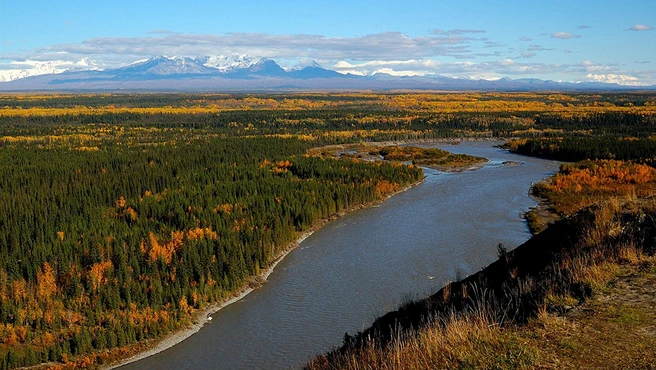Boreal forests span North America, Europe and Asia. They are characterized by cold-tolerant coniferous forests, currently dominated by spruces and pines, fir and larch trees are also present. This type of landscape is also called “taiga” and extends over a large area of the cold temperate climate zone of the northern hemisphere.
Dr. Lucia Layritz recently published a study in Biogeosciences as first author – she examines how climate change and increasing disturbances such as wildfires will affect the future of boreal forests.
Layritz’ study analyzes vegetation changes such as species composition and carbon storage, as well as biophysical properties like albedo and evapotranspiration.
By using a dynamic vegetation model, Lucia Layritz ran simulations that allowed her and collaborators to isolate the effects of warming temperatures and other climatic changes from disturbances such as fire on boreal forests, and to study the interactions between both factors. The results were revealing:
- Warming effects can lead to denser forests, as well as decreased albedo and increased evapotranspiration.
- Disturbances by themselves reduce tree cover in favor of shrubs and grasses. Moreover, disturbances may have the opposite effect of warming, with increased reflectivity and decreased evaporation. (This could potentially offset climate change impacts.)
- Together, warming temperatures and disturbances can lead to a reduction of coniferous trees, and a consequent expansion of deciduous varieties.
For Lucia Layritz, the findings highlight a greater need to account for disturbance-induced effects on vegetation and the interactions between disturbances and climate change. Ultimately, she hopes this work serves as further motivation to integrate disturbances into vegetation and Earth system modeling, despite the many uncertainties.
“Early on in my dissertation, I realized how little we understand about future forest disturbances,” said Lucia Layritz. “Real-world observation doesn’t let us isolate the drivers of change, but modeling does. By disentangling climate change impacts from one another, we can get a clearer view of fundamental processes that are driving ecosystem changes in boreal forests.”
Further Information
This article is based on a post by the Wendy and Eric Schmidt Center Data Science and Environment (DSE) in Berkeley, where Dr. Lucia Layritz is a postdoctoral researcher.
Original paper: Layritz, L. S., Gregor, K., Krause, A., Kruse, S., Meyer, B. F., Pugh, T. A. M., and Rammig, A.: Disentangling future effects of climate change and forest disturbance on vegetation composition and land surface properties of the boreal forest, Biogeosciences, 22, 3635–3660, doi.org/10.5194/bg-22-3635-2025, 2025.
